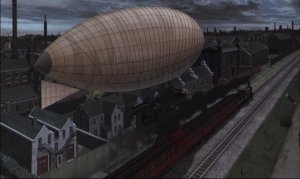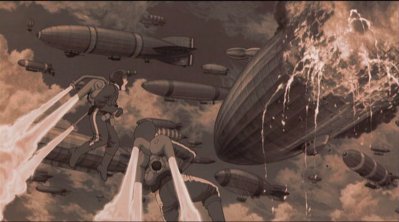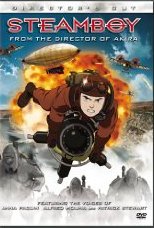Katsuhiro Otomo is best known for his post-apocalyptic anime Akira (1988), which became an instant hit in Japan and a cult classic in the United States. Though he wrote the screenplay for another futuristic anime film, Metropolis (2001), Otomo didn’t direct another full-length theatrical feature until 2004’s Steamboy, which took ten years to complete. Instead of exploring a future Japan, Steamboy takes us to a past that might have been: a Victorian England in a world where steam is the primary source of energy.
Young Ray Steam is a clever inventor like his father and grandfather, with an uncanny ability to understand complex engineering and machinery at a glance. One day he receives an unexpected package from his grandfather, Dr. Lloyd Steam, who was working with his son, Eddie, to collect a new mineral water that provides greater power in steam engines. The box contains his grandfather’s notes and a small metal “steam ball,” with instructions not to give it to anyone.
Minutes later, two shady characters from the O’Hara Foundation appear to claim the steam ball, but Ray refuses to hand it over. Dr. Lloyd arrives, tells Ray his father is dead, and orders him to deliver the steam ball to Robert Stephenson. Ray manages to escape on one of his inventions, a steam-powered monowheel, with the Foundation operatives pursuing in a self-propelled tractor.
Ray is rescued by none other than Robert Stephenson, the government engineer whom Ray is supposed to find. Before Ray can turn over the steam ball he’s kidnapped by a zeppelin and taken to the O’Hara Foundation headquarters in London, where the 1866 Great Exhibition is about to be held. There he meets the spoiled heiress Scarlett and is reunited with his father, who is alive after all but now part machine; half his head is plated in metal, he has a mechanical right arm and hand, and he lumbers like Frankenstein in heavy platform shoes.
 Ray’s father has undergone more than just a physical change: he is obsessed with building what he calls the Steam Tower, a flying fortress which can only be completed by the incredible power of the steam ball. Ray soon learns that his father is employed by the Foundation, creating devastating new steam-powered weapons for sale to the highest bidder. Realizing that his father is perverting science for his own diabolical purposes, Ray steals back the steam ball and tries to stop the rising threat of technology.
Ray’s father has undergone more than just a physical change: he is obsessed with building what he calls the Steam Tower, a flying fortress which can only be completed by the incredible power of the steam ball. Ray soon learns that his father is employed by the Foundation, creating devastating new steam-powered weapons for sale to the highest bidder. Realizing that his father is perverting science for his own diabolical purposes, Ray steals back the steam ball and tries to stop the rising threat of technology.
Steamboy has a fairly basic story (complicated by the quasi-plausible explanations of steam technology), in which all the characters are after a MacGuffin for their own reasons, much like The Maltese Falcon. Refreshingly, the villain doesn’t want money or power or to conquer the world—he only wants change. The Steam Tower isn’t a weapon, but a demonstration designed to capture the world’s attention and usher in the Age of Science. He knows the world can never go backward once people have seen what science can accomplish.
If Akira deals with the aftermath of uncontrolled technology (nuclear weapons), then Steamboy shows a world on the verge of losing control. Akira appropriately takes place in Neo-Tokyo, as Japan was the first victim of the atomic bomb, while Steamboy is focused on the Western world (here, the United States and England), which drove the Manhattan Project. There are further hints at greater themes throughout, such as the conflict between fathers and sons, and the debate over the usefulness and danger of technological advancement, but these are generally only given lip service—proposing the questions without choosing a side.
Yet the conflicts are surprisingly effective, even if understated. In the opening scene we see the elder Dr. Steam’s obsession with pushing his experiment to dangerous levels: “There is no progress without risk,” he says to his doubtful son. After Eddie is injured as a result, Dr. Lloyd’s enthusiasm for scientific progress mellows, but Eddie becomes even more fanatical—thus Dr. Lloyd thinks the son he knows is dead. Ray is somewhere in-between; as an inventor, he appreciates progress, but wants to ensure that it is used to make people happy. He’s aware of the dangers of too much progress too fast, and becomes the mediator between his father and grandfather so they can work together again. Ray also assumes the role of guardian against misapplied technology, and in an interesting twist, he only realizes this destiny because of his father. To borrow from one of the oldest and best science fiction films, Fritz Lang’s Metropolis (1927): “There can be no understanding between the hand and the brain unless the heart acts as mediator.”
 At its heart, Steamboy is a boy’s adventure, filled with a smart and scrappy protagonist, high-speed chases, aerial combat, explosions, cliffhangers, a sort-of unsympathetic love interest, personal conflict, a rousing musical score, and lots of cool machinery. The pseudo-Victorian setting contains all the props you expect to find in a steampunk story, as though Otomo were consulting a checklist when developing it, but the animation and design are truly stunning. Otomo directs with a deft hand, relying on a muted palette that suggests a different world firmly rooted in the past, frequently resorting to actual sepia tones for full effect. The film achieves a subtle blend of traditional cel animation and CGI, with is a bit less jarring than in the anime Metropolis—more The Iron Giant than Titan A.E. in its implementation. The technique is what contributed most to the unusually long development time of the film; fortunately the computer effects complement the hand-drawn animation almost perfectly, even if other animators beat Otomo to the punch. The film also contains many interesting compositions and clever directorial touches, which are lacking even in most modern live-action films.
At its heart, Steamboy is a boy’s adventure, filled with a smart and scrappy protagonist, high-speed chases, aerial combat, explosions, cliffhangers, a sort-of unsympathetic love interest, personal conflict, a rousing musical score, and lots of cool machinery. The pseudo-Victorian setting contains all the props you expect to find in a steampunk story, as though Otomo were consulting a checklist when developing it, but the animation and design are truly stunning. Otomo directs with a deft hand, relying on a muted palette that suggests a different world firmly rooted in the past, frequently resorting to actual sepia tones for full effect. The film achieves a subtle blend of traditional cel animation and CGI, with is a bit less jarring than in the anime Metropolis—more The Iron Giant than Titan A.E. in its implementation. The technique is what contributed most to the unusually long development time of the film; fortunately the computer effects complement the hand-drawn animation almost perfectly, even if other animators beat Otomo to the punch. The film also contains many interesting compositions and clever directorial touches, which are lacking even in most modern live-action films.
It’s fortunate that the movie is so much fun to look at, because the pacing can also be slow. This is a long film, two hours and six minutes, and there are many sequences showing the steam machinery at work and exposition about how the steam works, punctuated with frantic action. In one scene near the end, the film seems to be wrapping up with a dramatic farewell, but then another complication is introduced and the characters are off again, trying to prevent a catastrophe. Steampunk afficionados may not mind the drawn-out, loving glimpses of the world, and some will appreciate that the unavoidable glamorization of a steampunk world is contrasted with demonstrations of just how dangerous the technology is: people are scalded by steam, strangely frozen by high-pressure steam, injured when machines break, and injured when they work correctly (in the case of victims of weaponized steam-powered assault armor and tanks).
 Oddly enough, some of the film’s finest moments take place during the end credits, which display beautiful still images showing what happens after the end of the film. These frozen moments suggest the adventures that fill the gaps between them, leaving the viewer excited by parts of the story we may never see.
Oddly enough, some of the film’s finest moments take place during the end credits, which display beautiful still images showing what happens after the end of the film. These frozen moments suggest the adventures that fill the gaps between them, leaving the viewer excited by parts of the story we may never see.
If you rent or purchase this film on DVD, available in a “Director’s Cut” from Sony, the Japanese language track with English subtitles is superior to the dubbed English track. You may want to enjoy the visuals without the distraction of reading subtitles though, and the English voice cast is very good, including Anna Paquin (Ray Steam—yeah, I know), Alfred Molina (Dr. Eddie), and Patrick Stewart (Dr. Lloyd), though there are some small changes to the script that could annoy purists. French, Spanish, and Portugues tracks are also provided, as well as Spanish and French subtitles. Regardless of your chosen language, this film is highly recommended for animation and steampunk enthusiasts alike.
Eugene Myers wishes he could be a character in a Miyazaki film. The closest he can get to realizing that dream is by following the example of the young female protagonist of Whisper of the Heart, Shizuku, who writes a fantasy novel—which needs a lot of revision. He also sometimes breaks out into a poor rendition of “Country Road.”










